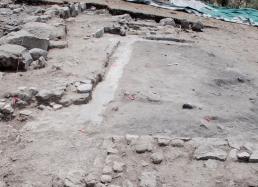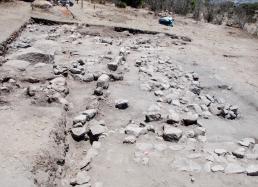5: A Village before a Fortress
In 1806, the French explorer, Guillermo Dupaix, visited the Mitla Fortress (then known as “Fuerte”) with an artist. Dupaix marveled at the prehispanic stone walls that encircled the site, producing the first known maps of the ruins that stand on this steep, rocky hill just west of the town of Mitla.
Later, in the 1800s, early anthropologists, including Adolph Bandelier and William Henry Holmes, visited this site, and the former produced maps of these tall walls that were more accurate than Dupaix’s early effort. Holmes, the Field Museum’s first Curator of Anthropology, spent more time in the town of Mitla, mapping the ruins there, and only visited the Fortress once. But he still considered the fortified hill as “one of the most unique and striking features of Mitla.”
From the first record of the site until 1980, little was known or considered about the Mitla Fortress beyond the imposing stone walls near the site’s apex. It wasn't until the regional study of the Valley of Oaxaca in 1980, led by Stephen Kowalewski of the University of Georgia, that archaeologists realized that down slope and ringing the walls of the Fortress were hundreds of terraces that likely housed prehispanic residences.
Linda Nicholas and I were part of that 1980 team, although we didn't map the Mitla Fortress itself at that time. Rather, we were focused on other parts or "arms" of the valley. However, in the mid-1990s, when we elected to focus on the eastern sector of the Valley of Oaxaca, near Mitla and Matatlán, we decided to prepare a more detailed map of the Fortress in 1998.
Both the 1980 and 1998 studies confirmed not only the existence of terraces at the Fortress, but also the presence of surface artifacts that indicated that the site was occupied long before the Postclassic period (ca. A.D. 900 - 1520), the time when the stone walls at the top were believed to date to.
The dating of the walls to the Postclassic period was not merely logical, given their exceptional condition, but also was confirmed by several investigators who noted Postclassic pottery sherds amidst the mud or adobe fill that held the stones of the wall together. The presence of these sherds in the earthen mortar strongly pointed to a Postclassic date of construction for the walls.
But what was the nature of the relationship between the famous walls at the top and the rest of the site? Was this site always and primarily a fortress, or is there more to its history? Our Field Museum excavations of two terraces in 2009 and 2010 have shown that although the Mitla Fortress was always a defendable location, the real concern with defense did not begin until toward the end of the Classic period (ca. A.D. 700 - 900), intensifying later during the subsequent Postclassic era. In other words, the Mitla Fortress appears to have been a pueblo or village before it was a fortress.
The two terraces that we excavated housed residences that were first built and used during the Middle to Late Classic period (ca. A.D. 500 - 750). At that time, the residential complexes appear to have been relatively open, with passages between terraces, and a low retaining wall at the front of the terrace (see Photo #1 below.)
When the complex was rebuilt later in the Classic period, the residential complex was more closed and the walls at the front of the terraces were reinforced and raised (see Photo #2 below.) The amplification of walls at the front of the terrace continued during the Postclassic period, even after the residences on the terraces that we excavated were no longer in use.
During the last prehispanic use of Terraces 56 and 57, where we're currently excavating, large stones were placed above adobe walls that were built on the earlier the retaining wall, yielding in a sense a lower, mid-slope, encircling wall of stones below the massive defensive features at the top. The concept of using an adobe core faced with stones was also employed for constructing the walls at the top of the Fortress (note the lower left corner of the image at the top of the page).
The greater concern for defense at the end of the Classic period may be hypothesized to relate to the weakening power of Monte Albán at that time and the emergence of many smaller centers, whose ruling families jockeyed for power, perhaps for centuries. To test this hypothesis, we need a better understanding of the Late Classic and Postclassic periods across the Valley of Oaxaca. Certainly, we know orders of magnitude more about this region’s history than was understood a century or two ago by Dupaix or Holmes, and yet we still have so much to do and learn.
Word of the Day: fortaleza, which means “fortress.”
More soon,
Gary




